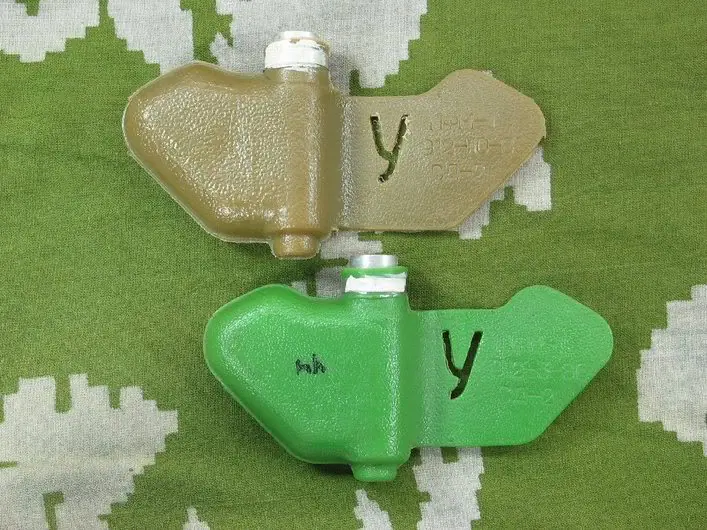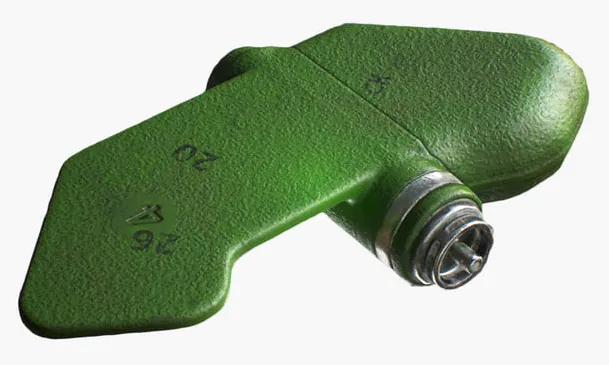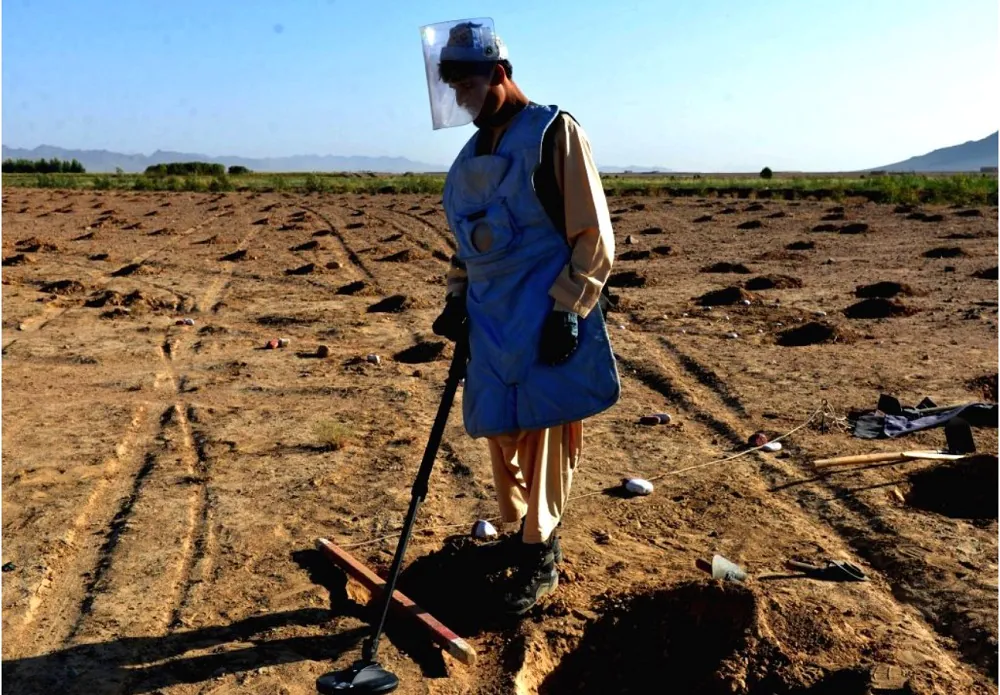© ROOT-NATION.com - Use of content is permitted with a backlink.
Today we are going to talk about the deadly PFM-1 mini butterfly mines and how to act in order to stay safe in case of encountering them.
I never thought that I’d ever be writing about anti-personnel butterfly land mines. The first time I saw them was at the training ground in the distant 1989, back then we were told about them and trained to find them in thick grass. Even then, we learned that these mines were prohibited by military conventions, including the Geneva Conventions, and that their use is an international criminal offense. The major, who secretly conducted the classes, said that they were widely used in Afghanistan at the beginning of the war, but later abandoned because it was very scary to see small children with their feet torn off. At that time it was something from another world, from the distant world of war.

And now, in 2022, in my native Kharkiv, orcs are dropping cluster bombs with such mines, their ‘newest’ engineering system of remote minelaying ‘Zemledelie’ is scattering such mines in and around the city. What is this but genocide and a crime against humanity? These facts only prove the unscrupulousness and insidiousness of the russian fascists. They are inhuman criminals and terrorists. Such crimes cannot be left unpunished.

Today I will talk in more detail about these deadly mini-traps, invisible enemies that can maim children, adults, the elderly. They can leave a person crippled forever.
Read also: Weapons of Ukrainian victory: ATGM Javelin FGM-148 – ruthless to enemy tanks
History of development of the butterfly mine
Landmines became widespread in the late 19th century and were used during the war by almost all developed countries in the 20th century. At first, mines were usually powerful enough to kill a person or even several people during a detonation. Over time, mines became smaller and smaller, and were usually intended only to injure enemy personnel. The idea was that if a soldier was wounded, he would have to be taken care of by other soldiers, which would have to use more resources than if the soldier had just been killed. In addition, there was a factor of fear, for example, to deter an attack. The movement of infantry itself was slowed down, because it was necessary to be more careful and cautious when passing through minefields.

Beginning in the 1950s, the Soviet Union began developing small anti-personnel mines that could be dropped from aircraft. One of the popular mines they developed was the PFM-1 anti-personnel mine. Small, made of plastic, so it could be mass-produced in Soviet factories and used almost in unlimited quantities. At that time, such a mine had many names, such as ‘Green Parrot’, ‘Butterfly Mine’, ‘Petal’, but the most sinister was the name ‘Soviet Death Toy’.
Read also: Weapons of Ukrainian Victory: Review of Starstreak MPADS
Where were these landmines used?
The butterfly landmines were first used during the Israeli-Syrian conflict in 1973, but were most widespread during the Soviet occupation of Afghanistan. During the ten-year occupation, millions of such mines were used, for example, to mine mountain passes or roads, to set traps for enemy soldiers.

They were also used to mine border areas to prevent enemy militants from crossing the border. Soviet troops left Afghanistan in 1989 and, as a ‘small gift’, planted many of their surplus mines along paths and roads, most of which are still there today. Small time bombs that wait for a person to accidentally step on it. It seems that in Ukraine, after the Victory, we will also have to look for and neutralize these terrible ‘presents’ from the ‘liberators’, let them burn in hell!
Read also: Weapons of Ukrainian victory: FIM-92 Stinger MPADS
How does PFM-1 look like?
As the name implies, a mine looks like a butterfly or a parrot, it has two ‘wings’, thin and thick. The thick part contains liquid explosives, and the thin part is used as a stabilizer when falling from a height. The construction of the mine is mostly plastic, the only metal part is a small aluminum fuse between the two wings.

The mines are mostly green, although colors can also vary from brown to white, depending on the area where they are to be used. The mine is only 61 mm (2.4 inches) long and only 20 mm (0.7 inches) at its widest part.

The total weight of the mine is 75 g (2.6 ounces), of which 37 g (1.3 ounces) is the explosive itself.

How are these landmines deployed?
When deployed, the mines are packed in a dispenser that holds 34 small mines. The dispenser has a metal pin attached to the fuse of each mine to prevent premature detonation. Once the mines are above the planned location, they are released from the dispenser and ‘fly’ to the ground, a thin wing helps to slow down its descent and scatter mines over a larger area. After release, the locking pin is removed and the mines can detonate within 40 minutes of release. These are the so-called cluster bombs you’ve been hearing about lately.

Of course, not all mines explode, many of them simply lie on the ground unharmed, which poses an additional threat not only to the military but also to civilians. PFM-1 is a very sensitive anti-personnel mine. The fact is that the applied force of 5 kg (11 pounds) is enough to detonate the mine, so they are extremely dangerous even for small children. They explode as a result of deformation of the plastic cover. It is enough, for example, to step on it with a shoe or throw a stone at it. The explosion is small, but it is enough to amputate a leg or arm.
Another version of this mine was later developed under the name PFM-1S. Such mines self-destructed 24 hours after deployment. However, they were not as effective as the original version, because the movement of enemy over minefields did not always take place during this period. But who knows if this version is still left somewhere in the munition depots of the orcs.
Horrendous consequences of landmine deployment
It is estimated that there are still about a million mines left in Afghanistan, most of which are PFM-1 models. It is known that after the Soviet invasion in 1978, about 30,000 Afghan civilians, many of them children, were blown up by mines. You might wonder why so many children are falling victim to these mines. Of course, because children think these are toys.

The appearance and small size of the mine resembles a toy bird or a butterfly, which attracts the attention of children. In addition, unlike many anti-personnel mines, they are very sensitive, so even a child who does not weigh much can easily detonate them.
You could see these mines in the movie ‘9th Company’. Below is a fragment from this movie.

We do not yet know the real scale of deployment of these mines in Ukraine. But you still need to be careful, tell children about them, warn them against picking up unknown objects from the ground. This will save their health.
Read also: Invasion of Ukraine: Bayraktar TB2 strike UAV review
Is it easy to find and disarm the butterfly mine?
Of course, many of you have a question: why are these mines still not banned and not cleared? First, it is expensive, costly. Second, a lot of them were released, so warehouses were overwhelmed with them. Even in Ukraine, they still lie in military depots. After all, they could be simply forgotten, documentation could be lost, so they just lie on the shelves. But the russian fascists decided it was time to use them.
Is it easy to defuse such mines? I will tell you about the example of mine-clearing in Afghanistan. More than 30 years have passed since the withdrawal of Soviet troops from the country, and mine-clearing continues to this day.

When a mine-clearing team arrives at the area, it first interviews locals to find out where the minefield may be. The small size and light weight of such mines complicates the process of finding them. Another difficulty is that mines can move through natural processes such as rain, melting snow and landslides. Therefore, the minefield may shift even before the locals realize this, which further complicates the efforts of mine-clearing teams.
The big problem is also that they are made mostly of plastic. That is, they are quite difficult to find with metal detectors, which are commonly used to search for mines. In order to find mines, operators must significantly increase the sensitivity of their equipment. Increasing sensitivity creates more false positives, which in turn makes the process even more time consuming and expensive than searching for metal mines.

Another problem with plastic butterfly mines is that they do not corrode, so they do not break down over time as easily as steel mines. Especially in Afghanistan’s arid climate, these mines are likely to remain operational until they are disarmed and disabled. Finally, such mines had often been spread on mountain passes and along public roads, so they are located in areas with heavy traffic. Many of these passes are the only way to cross the mountains, so locals often run the risk of using them despite the danger.

In Ukraine, the occupants drop such mines in densely populated areas, so the risk of injury is also very high.
Read also: Switchblade: American kamikaze drones to protect Ukraine
Modern mine detection technologies
As technology advances, faster and more cost-effective solutions are used to find mines. One such technology is thermal imagers. Mine-clearing teams are now using drones with thermal imaging cameras to locate them.

Being made mainly of plastic, mines emit heat, so their temperature is different from the temperature of the earth around them. Especially in hot, mostly sandy parts of the country, where the sand cools quickly at night and the plastic retains heat longer, which allows demining teams to locate mines. This new technology does not work everywhere and is far from perfect, but it is much faster and more accurate than traditional methods.
As technology continues to evolve, even more effective mine detection techniques are likely to emerge in the future.
Read also: Best video games developed in Ukraine
What should you do if you found a butterfly mine?
If you find a deadly mine, do not try to disarm it yourself. Fence the place of discovery, inform the relevant security services, tell your neighbors about the danger.

Tell children about mines, show photos, even download a picture of a butterfly mine to your child’s smartphone, warn them not to pick up such objects, look down at their feet while walking. The more children know about them, the less risk they will fall into a mine. Try to carefully inspect the playground where your child is playing for dangerous objects. Be careful and cautious! Your health and the health of your children depend on your actions and attention!
Read also: Best music to come out of Ukraine: Famous rockers, Eurovision darlings, and everything in-between
Do invaders deploy butterfly mines on purpose?
There can only be one clear answer: yes. They want to stop the counteroffensive of the Armed Forces of Ukraine, keep them at a distance, prevent them from moving quickly and regrouping. Of course, this does not honor the occupying forces, but what military honor and conscience can we talk about when they are at war even with civilians? Orcs want to intimidate the civilian population of Ukrainian cities and villages. But the constant shelling and bombing with GRADs, Tornadoes, cruise missiles and aircraft did not break the spirit of the Ukrainian people. We repel the russian fascists with dignity, which is why they resort to such vile and insidious actions.
But still the victory will be ours! Because we are on our land, we are at home! Glory to Ukraine!
You can also help Ukraine fight with Russian occupants via Savelife or via an official page of the National Bank of Ukraine.
Read also: Weapons of Ukrainian victory: ATGM Stugna-P – Russian tanks are in trouble


I used to think the kids were pretty stupid for grabbing some random plastic trash but that’s not what happened. These mines are pretty simple, it’s just a pressure sensitive explosive, so it will detonate if squeezed from any direction. And they are small. This makes them ideal for making all kinds of simple booby traps. The russian soldiers in afghanistan used to cut open teddy bears or a ball and put one of these mines inside and put it where a kid would inevitably grab it.
Their methods have not changed, although now they mostly cover their retreats with these mines so that the Ukrainians cannot finish them off in pursuit. They also scatter them from time to time for provocations in the occupied territories of Ukraine (mainly to blame the Ukrainian army). In the Kyiv region, many owners of apartments and houses, when they returned to their homes after liberation, found them completely looted by the Russian military, as well as mined refrigerators, doors, pianos, cabinets, and other things. The Russians simply left such deadly surprises behind, knowing that civilians and possibly children would find them.
The Russian occupiers are terrorizing the civilian population in order to create panic and an atmosphere of hatred, but they are trying to blame the Ukrainian military for their crimes. And it’s their traditional policy to do something terrible and say “it’s not us”. Fact.
Yep, thats true.
Russian fascists drop these mines on civilians. Damn you!